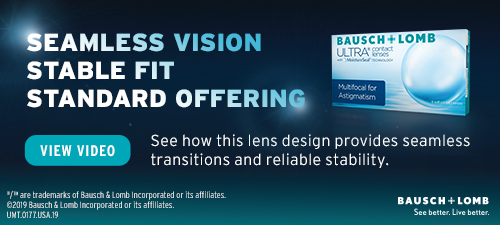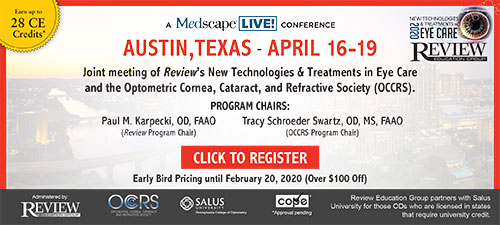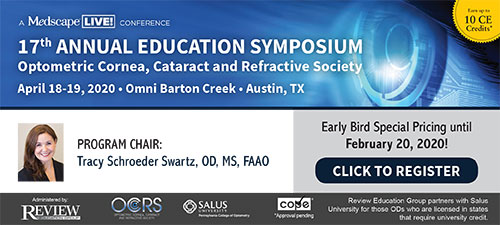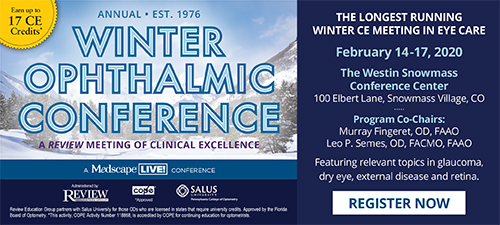
A
weekly e-journal by Art Epstein, OD, FAAO
Off the Cuff: Tips on Tears
A few weeks back I posed an interesting question. Given increasing recognition that the ocular surface environment is very dynamic and far more complex than most of us were taught, could some treatments have unintended adverse consequences? The specific question was, can lipid-based supplements or topical medications actually result in downregulation of meibomian gland function, leading to eventual dysfunction and even loss of glands? The answer is we don’t really know, but it is something astute clinicians should be pondering. It may well be that clinical failure is more than a simple lack of efficacy, but rather a result of greater negative than positive impact. Some readers asked if I stopped using lipid-based products because of these concerns. The answer is simple: I do what’s best for patients. Clinically, lipid-based supplements and medications have clearly observable benefits. So, when a patient is successful on Restasis, they stay on Restasis. When a patient who is lipid deficient needs a tear supplement, I reach for a lipid-based product. While many patients, when successfully managed, decrease or stop using artificial tears, most patients we initially see still require them. Our goal is to help them select the best one. Choosing a go-to tear supplement is not as easy as you might think, especially for someone who prides himself on being a closet surface chemist. A lot of chemistry and physics goes into the design and formulation of modern supplements. In keeping with a generally holistic approach as a foundation of treatment, my mainstay tear product has become Allergan’s non-preserved Refresh Optive Mega-3. The formulation incorporates flaxseed oil, a natural touch, and it was my patients who actually first brought the product to my attention and led me to start recommending it. Acceptance and performance were so overwhelmingly positive that it has become our number one choice, and every new patient leaves with a sample. We use a variety of other tears as well for specific purpose, Freshkote being a good example. So, do tear supplements help or harm? In the long run, the jury may still be out, although the many years of use suggest unlikely negative impact. In the short term, they are often essential elements in managing even the most challenging patients. However, one thing is for certain: Not all tears are created equally. Some simply are more effective, and are designed and work better than others. Choosing the right one for the right patient can make a huge difference.
|
|||||
 |
||
| Correlation Between Blood Flow on Optic Nerve Head and Structural and Functional Changes in Eyes with Glaucoma | ||||
The purpose of this study was to determine the significance of the correlations between blood flow on the optic nerve head (ONH) using the mean blur rate (MBR), determined by laser speckle flowgraphy, and the visual field loss, determined by perimetry and the structural alterations by optical coherence tomography in eyes solely with open-angle glaucoma. There were significant differences in the circumpapillary retinal nerve fiber layer thickness (cpRNFLT) and the MBR-tissue, at the different stages of glaucoma. Univariate linear regression analyses indicated that the mean deviations (MD) were significantly correlated with both the MBR-tissue and the cpRNFLT. Logistic regression analyses showed that the MD was significantly correlated with the MBR-tissue and the cpRNFLT. The MBR-tissue was found to be the factor that can best predict the MD, based on the Akaike information criteria. Stepwise multiple logistic regression analyses showed that the MBR-tissue and the cpRNFLT were both risk factors that were significantly associated with the MD. Researchers wrote that the results indicated that the MBR-tissue was as important as the structural values in diagnosing and determining the prognosis of glaucoma.
|
||||
SOURCE: Kuroda F, Iwase T, Yamamoto K, et al. Correlation between blood flow on optic nerve head and structural and functional changes in eyes with glaucoma. Sci Rep. 2020;10(1):729. |
||||
 |
||
| Accuracy of the ISNT Rule and Its Variants for Differentiating Glaucomatous From Normal Eyes in a Population-based Study | ||||
Researchers evaluated the accuracy of the ISNT rule (I=inferior, S=superior, N=nasal, T=temporal) and its variants with neuroretinal rim width and retinal nerve fiber layer (RNFL) thickness measurements differentiating normal from glaucomatous eyes. The diagnosis accuracy of the ISNT rule and its variants was evaluated in a population-based study. Neuroretinal rim width was measured on monoscopic optic disc photographs with an image-processing program. RNFL thickness measurements were obtained with spectral-domain optical coherence tomography (SD-OCT). In this study including 940 normal subjects and 93 patients with glaucoma, the sensitivity of the ISNT rule with optic disc photographs was 94.1% (95% CI, 90.2 to 98.1), whereas its specificity was 49.2% (46.9 to 51.6). When using the IST rule, the sensitivity decreased to 69.9% (62.1 to 77.6) with a higher specificity, 87% (85.3 to 88.6). All the diagnosis indicators were somewhat lower for the different rules using RNFL thickness: the sensitivity of the ISNT rule was 79.4% (72.6 to 86.2), and its specificity was 34.1% (31.9 to 36.4). With the IST rule, the sensitivity decreased to 50% (41.6 to 58.4) while the specificity increased to 64.9% (62.7 to 67.2). Researchers determined that ISNT and IST rules applied to neuroretinal rim width measurement by optic disc photographs were useful and simple tools for differentiating normal from glaucomatous eyes. They added that the translation of these rules to RNFL thickness by SD-OCT was of limited value. |
||||
SOURCE: Maupin E, Baudin F, Arnould L, et al. Accuracy of the ISNT rule and its variants for differentiating glaucomatous from normal eyes in a population-based study. Br J Ophthalmol. 2020; Jan 20. [Epub ahead of print]. |
||||
 |
||
| Schwartz-matsuo Syndrome: an Important Cause of Secondary Glaucoma | ||||
Investigators reported a case of Schwartz-Matsuo syndrome that highlights the pathophysiology, diagnostic challenges and management considerations of this rare disease. Schwartz-Matsuo syndrome is a condition characterized by rhegmatogenous retinal detachment, cells in the anterior chamber (AC) and elevated intraocular pressure (IOP) in the evening. A 31-year-old man with a history of left eye cataract presented with left eye photophobia and elevated IOP of 64mm Hg. Visual acuity was 20/40. He head open angles with an increased pigment of trabecular meshwork by gonioscopy, 2 + AC cell, superior retinal detachment and 0.6 cup-to-disc ratio. Electron microscopy of AC fluid demonstrated outer segments of photoreceptors. IOP was lowered with oral and topical ophthalmic antihypertensives. Retinal detachment was treated with pars plana vitrectomy with endolaser, gas tamponade and AC paracentesis. Follow-up revealed VA 20/20 with normal IOP. Investigators wrote that Schwartz-Matsuo syndrome was characterized by elevated IOP with marked fluctuations, open angles, aqueous cells and retinal detachment. They added that diagnosis was supported by electron microscopy of AC fluid with outer segments of photoreceptors. Treatment included retinal detachment repair and antihypertensive therapy. |
||||
SOURCE: Etheridge T, Larson JC, Nork TM, et al. Schwartz-Matsuo syndrome: An important cause of secondary glaucoma. Am J Ophthalmol Case Rep. 2020;17:100586. |
||||
| News & Notes | ||||||||
| Aerie Receives FDA Nod for Athlone Facility to Produce Rocklatan Aerie Pharmaceuticals announced that its sterile fill production facility in Athlone, Ireland, received approval from the FDA to produce Rocklatan (netarsudil and latanoprost ophthalmic solution) 0.02%/0.005% for the U.S. market. The regulatory clearance of the plant follows a successful preapproval inspection of the facility and FDA review of the New Drug Application Prior Approval Supplement, which added the Athlone production facility as a drug product manufacturer for Rocklatan. Read more. |
||||||||
| Eaglet Eye Offers Two New Features for Eye Surface Profiler Eaglet Eye announced at the Global Specialty Lens Symposium two new features for their Eye Surface Profiler (ESP). The Scleral Profiler, which now allows practitioners to quickly determine if they should pursue a spherical, toric, quad or fully custom scleral periphery, was designed to accelerate the fitting process with the ESP. The second feature, the ability to enter the over-refraction to allow for more seamless interaction with the lab of choice, is intended to help reduce complications when ordering scleral lenses. Learn more. |
||||||||
|
||||||||
|
Optometric Physician™ (OP) newsletter is owned and published by Dr. Arthur Epstein. It is distributed by the Review Group, a Division of Jobson Medical Information LLC (JMI), 11 Campus Boulevard, Newtown Square, PA 19073. HOW TO ADVERTISE |


